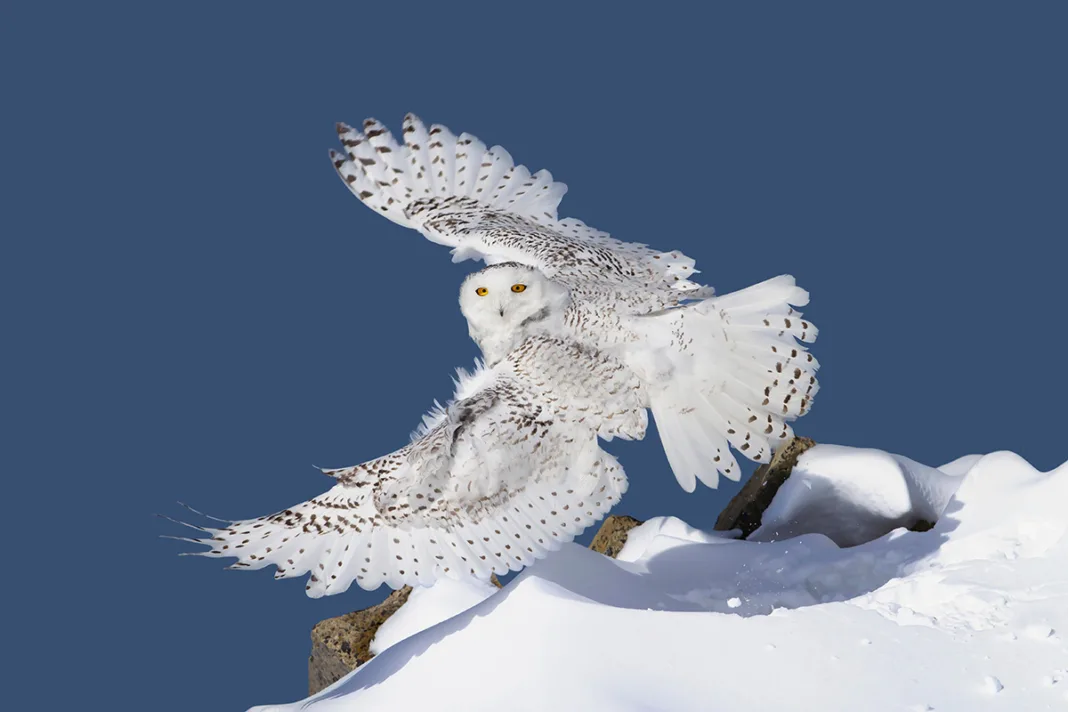When Graham Wellstead was met coming off an aeroplane in Canada by a snowy owl, it got him thinking about one of his all-time favourite owls and why, unfortunately, this species is not such a regular visitor to the British Isles as you might be led to believe
THERE was a wedding in the family between Christmas and New Year. I flew into Edmonton in Canada during a snowstorm, seeing nothing until we landed. My daughter and future son-in-law-to-be picked us up. Walking out of the airport into the freezing wind and fresh snow, the first thing I saw was a female snowy owl sitting on top of a lamp post. It was almost as if I was getting a personal greeting from one of my favourite owls.
Judging from a tea towel frequently sold in stately home shops, the snowy is one of six native owls. Sadly, this is not strictly true. I guess it is easier to balance six rather than five. It is not a resident breeding bird, although we do have rare winter visits from individuals. There were more frequent visits to the Shetlands in the 1920s and 30s, but these declined and by the 50s they were, once again, rare.
However, a nest was eventually recorded on Fetlar in the Shetland Isles in 1967 – the first ever recorded. That first breeding produced five owlets from seven eggs hatching and surviving to fledging. The pair continued to produce young for the next eight years, although not at the same rate. Yet, apart from one unsuccessful breeding by a second female – when eggs were laid but failed to hatch and after that the original male disappeared – there have been no further attempts.
This is a sad tale for the snowy, which would be a welcome addition to our native fauna. I wonder why it failed to establish? Was the lack of lemmings the reason? As the snowy’s diet includes other mammals and birds, often taken in the air, it is unlikely. Young owls brought up not having seen a lemming, let alone eaten one, would hardly be likely to miss it. Birds bred in captivity seem to exist perfectly well on a diet of day-old chicks, rats, quail, and in the case of one pair – hamsters.
We do have a well-established captive population and few falconry display centres and bird gardens are without at least one pair, with some being flown in demonstration. The snowy is a large owl with a wingspan of 1.5m (5ft) and it is very agile. Most displays have the bird fly from post to fist and back, which, while giving you a better view of this lovely bird, does not often show its real ability. Seeing a male drive off an arctic fox, striking it from behind, then whirling round to come back and repeat the attack several times, brought that home to me.
No article about the snowy owl is complete without mention of Harry Potter and his owl, Hedwig. I must admit to a reaction of sheer horror when I first saw the publicity shots for the film with a snowy owl in a parrot cage. Knowing the film industry’s ability to cause a “must have” reaction to something as beautiful, I was much relieved when the owl did not become a fashion accessory. This, I think, says a lot for those who bred them, who I am sure turned down many requests.
We have two white owls in aviculture in the UK, neither of which is strictly all white. The barn owl is normally buff above with a white shirt front in the male and spotted to a varying degree in the female. Although there are a few pure white barn owls in captivity, as far as I am aware, this is the only mutation.
The sex of a snowy owl is quite obvious. First, the female is larger and darker with heavy black and brown speckling, even in her first year. The young males are distinctly whiter, but also more marked in their first year. Markings reduce with subsequent moults, but he always retains some. Something you would not expect is the colour of the owlets. They are covered in dark grey, almost charcoal, down – except for their lower legs and feet, which are white. I always think of them as wearing white socks. They all have bright yellow eyes and a black bill.
The snowy owl is a charming addition to a collection and, when hand-reared, ( I reared a small number myself), become wonderfully tame and endearing. My wife, who is less than enthusiastic about my birds, would quite happily carry our male snowy chick “William’ around, cradled like a child in her arms.
Graham Wellstead runs the Wey Valley Falconry in Surrey.
Find more news and articles like this on the Cage & Aviary Birds website. Subscribe to Cage & Aviary Birds magazine now.


